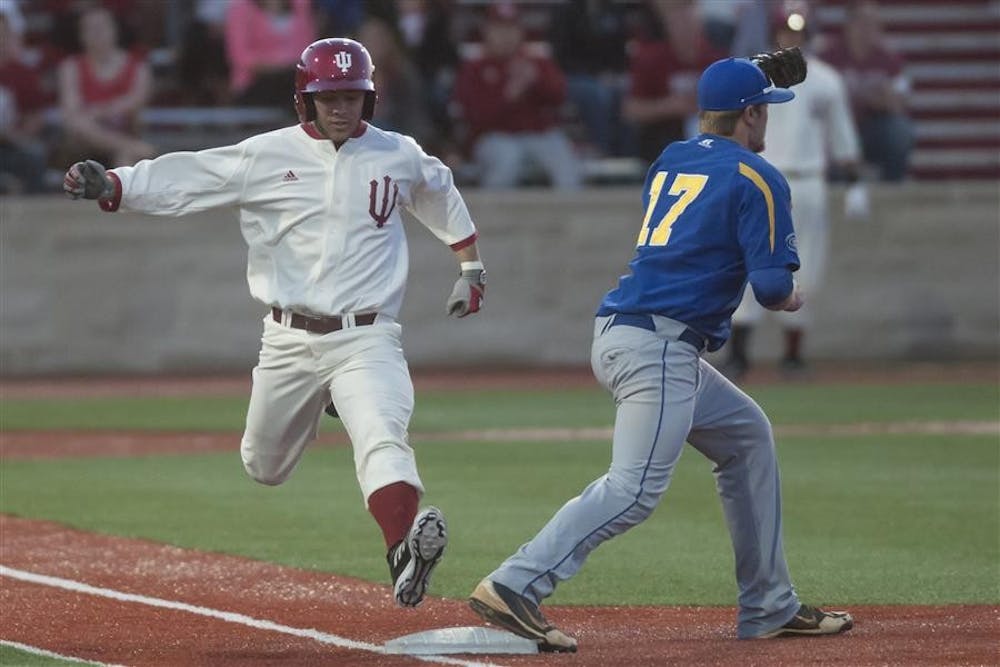Casey Rodrigue stands on first base. His goal is simple — steal second.
The junior is the team’s leadoff hitter. He gets things going for the offense and has two preseason All-Americans — Kyle Schwarber and Sam Travis — hitting behind him. He leads the team this year with 10 stolen bases, which also ranks tied for seventh in the Big Ten.
Rodrigue, a junior college transfer, stole 68 bases last year at LSU-Eunice. IU Coach Tracy Smith said Rodrigue doesn’t have great straight line speed. What attracted Smith was Rodrigue’s quickness and his initial burst off the base paths when trying to steal a bag.
“It was kinda a manhunt,” Smith said. “ ... We just literally cold-called a lot of junior college programs in the country.”
After time in various slots in the lineup in the beginning of the season, Rodrigue has cemented himself as the team’s leadoff hitter. When he’s on first base after a single or a walk, he said, he studies the pitcher’s tendencies to know the optimal time to steal a bag.
Rodrigue will count how long the pitcher stands motionless on the mound.
If the pitcher has a “tell,” or he does something different than what he normally does, Rodrigue knows the pitcher will probably try to throw to first and pick him off.
“I’ll count, ‘one Mississippi, two Mississippi,’” Rodrigue said. “The better pitchers will vary their tendencies between holds and picks.”
When a right-handed pitcher is on the mound, sometimes he moves his front foot forward before the back foot comes off the rubber, Rodrigue said.
The move is technically a balk and should be penalized, but pitchers get away with the move most of the time, and they try to pick off the runner at first by confusing them with their footwork.
“It’s kind of undetectable to an umpire that’s standing behind a runner,” Rodrigue said of the illegal move.
When studying an opposing pitcher, Rodrigue said he is looking for variance in head motion, how long the pitcher takes in between pitches and whether he’s right- or lefthanded.
He’ll also look for whether the pitcher will throw a fastball or an off-speed pitch. Rodrigue knows what counts are typically fastball counts and what counts pitchers throw curveballs or changeups.
That difference in the speed of the ball getting to the catcher gives him more time to break for second base, even if it’s just a few mph difference.
And that’s just for stealing second. Rodrigue said stealing third is more challenging. Instead of a catcher throwing 127 feet and 3.375 inches from home to second base, he only has to throw 90 feet.
“On first and second, you’re more willing to take that gamble,” Rodrigue said. “You can’t live and die with being out at third. But you can take that chance at second. So you have to be 100-percent sure when taking third.”
Rodrigue hasn’t been able to run as much as he did last season in junior college, because he has two all-American and MLB prospects hitting behind him — Schwarber and Travis. The risk of making an out when two big bats are behind him isn’t worth it.
The speedster used to have more freedom in junior college when deciding whether to steal. Here at IU, Smith has taken that responsibility out of his hands. Rodrigue looks to Smith, who is also the third-base coach, when deciding whether to steal or not.
“One of the things he did early was try to make too many plays,” Smith said. “So I’ve kind of taken some of that out of his repertoire there.”
Rodrigue said he has never stolen home in his career. But he wants to.
“A buddy of mine did it in junior college, did it in the World Series one time. Won us the game,” Rodrigue said. “That’d be pretty cool.”
Rodrigue explains art of stealing

Get stories like this in your inbox
Subscribe



